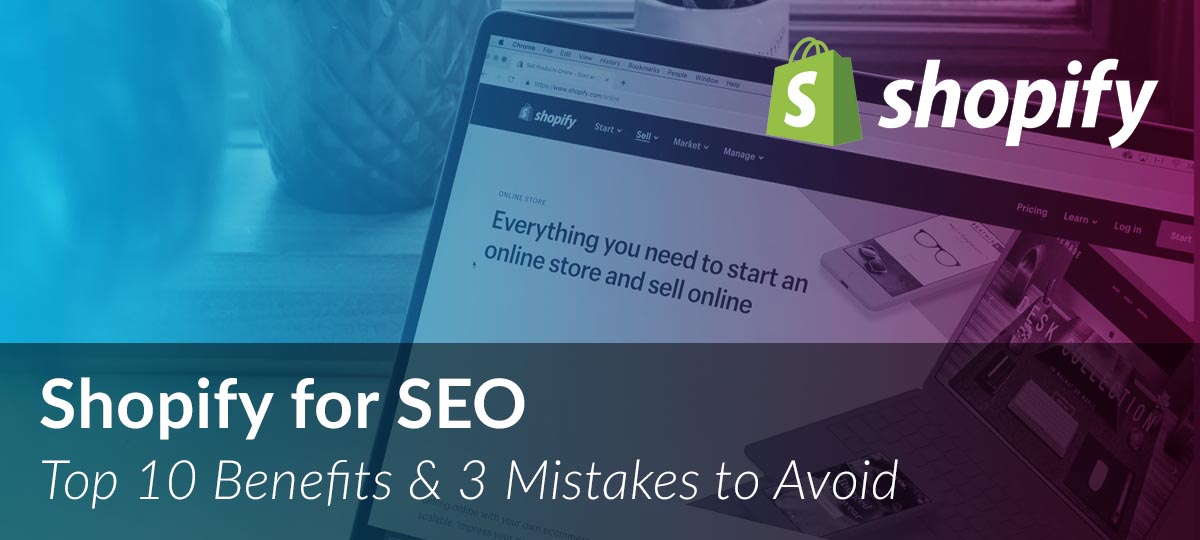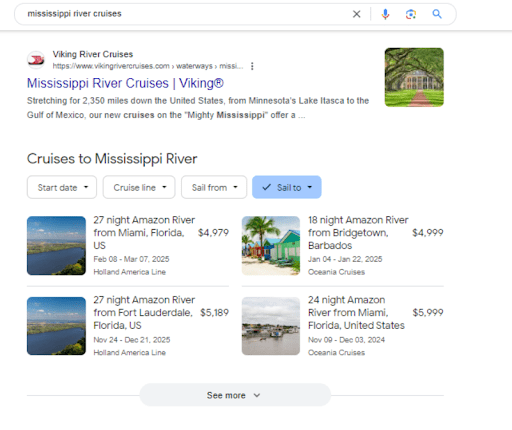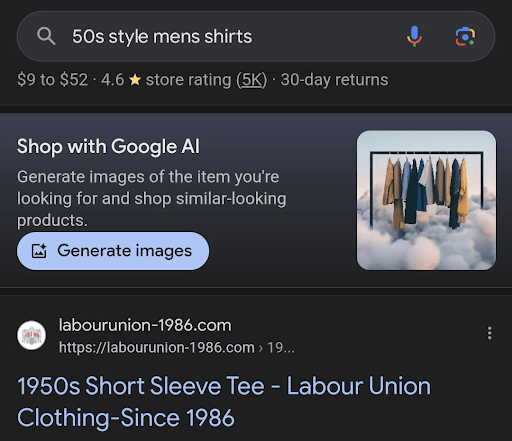
Are you trying to make your ecommerce business’ website stand out in a crowded digital space?
Do you feel lost when it comes to getting your Shopify noticed by Google? You are not alone. In this article, we will share how to make the most of Shopify for SEO, explore its benefits and help you to avoid common mistakes.

Nothing is more frustrating than putting effort into setting up an online store, for no one to visit. As an ecommerce business owner, you know how important it is for your store to show up in search results. It’s important to understand how to improve your Shopify store’s visibility in search results, so you can attract more customers and grow your business.
Shopify’s tools can also be tricky to understand, especially if you’re not sure where to start.
We have listed some of the most useful benefits and avoidable mistakes to help you understand what works and what doesn’t in SEO for Shopify stores.
Whether your ecommerce site is grappling with fierce competition, battling low rankings in the search results or you are keen to broaden your knowledge with ecommerce SEO to become more confident, the Varn team have put together this article to help you understand how Shopify can be used to follow SEO best practices.
Shopify’s CMS makes it easy to create and manage content for ecommerce websites, with simple monthly plans to sell products. The platform has over 600,000 merchants across the world. Shopify regularly updates their platform with new features and integrations. The recent, tap to pay on iPhone, and twitter sales channels are efforts to improve user experience, increase traffic and attract more customers.
Any online purchases made via your ecommerce site need to be secure. A user expects an ecommerce site to protect their sensitive data. Shopify’s secure hosting includes a free SSL (Secure Sockets Layer) certificate, which enables HTTPS encryption, for all their hosted websites.
This HTTPS protocol signals to search engines that the website is secure. Google highlights security as criteria for a good page experience and gives preference to secure websites. This core aspect of technical SEO is not overlooked for ecommerce websites that use Shopify.
Without it, your site won’t rank well in searches.
Structured data, also known as schema markup, translates page details to search engines to suggest which product details to show in the SERP. The Shopify platform has an easy way to add structured data markup.
Ecommerce websites are no longer bound to the format of page title, meta description and URL. Rich snippets are a fast track to the top of the SERP. As manager of a team that’s rooted in Technical SEO, I’m no stranger to the opportunities schema provides that ecommerce businesses to benefit from.

Rich snippets your business can rank for using Shopify
Google updates and adds features to the Search Results Page (SERP) more than ever before. One of the most recent is Google’s recent SERP feature, specifically designed for cruises. Additionally, Google’s new Search Generative Experience (SGE) plans to introduce AI in the SERP, some of the most recent updates we’ve noticed is Shop with Google AI feature.

A non-negotiable of a website’s technical SEO set up, is a well-organised sitemap. An XML sitemap is a file that lists all the pages on your website, in a structure that reflects their relevance and importance. It should be easy for search engine crawlers to navigate, understand site structure and index the pages on your ecommerce site. If Google can’t reach a page easily, how will it rank it?
Without a crawlable site, Google cannot and will not rank anything. To create an XML sitemap manually may be a challenge if you’re new to SEO and can take a long time. Whereas, with Shopify, a sitemap for your ecommerce website is automatically generated.
Canonical tags help search engines understand the preferred version of a page, especially handy if there are multiple pages with similar content. Canonical tags are especially useful for ecommerce sites with product variants, filters, pagination, and cross-selling pages. The Shopify platform anticipates this dilemma with automatically generated canonical tags.
This feature simplifies the technical aspects of SEO for business owners, but also helps to prevent issues like duplicate content penalties. With Shopify’s automated generation of canonical tags, businesses can focus on their products and content.
Whilst Shopify auto generates canonical tags they should be strategised, monitored and planned. An organised structure helps people and search engines to find what they are looking for, without being overwhelmed or confused with lots of similar products.
Hubspot’s 2023 Web Traffic & Analytics Report found that:
“54% of consumers primarily use phones to search.”
Google announced, via their Google Search Central Blog, that “We will be expanding our use of mobile-friendliness as a ranking signal.” As mobile searches continue to dominate, Google has made mobile-friendliness a crucial ranking factor.
81% of Shopify traffic comes from mobile devices. So it’s no surprise that Shopify themes are made for mobile users, with mobile-friendliness and integrations. A responsive theme helps avoid user’s bouncing off the page because a page hasn’t loaded correctly.
Page speed, sometimes called ‘load speed’ measures how fast the content on a page loads. The speed of a website is a crucial factor in SEO.
When someone uses your ecommerce store, the user has a specific purpose, they expect to find the information, or a specific product or service quickly otherwise they will leave.
The average adult attention span is 8 seconds. Waiting 4-5 seconds for a page to load isn’t good enough. Each second the user is waiting for your ecommerce site to load is a second that they not only lose interest, but your business loses credibility. There’s a correlation between conversion rate and load speed. For ecommerce businesses, this shouldn’t be overlooked. A page’s load speed can be the difference between a sale and a user leaving your site.

Shopify has built-in speed optimisation features into its platform. One such feature is the integration of a content delivery network (CDN), which considerably enhances page loading times. This, in turn, not only improves the user experience but also provides preferential treatment to faster-loading pages in search engine algorithms, resulting in higher rankings.
Shopify’s app store drives the number of ecommerce sales made with online businesses. A large collection of apps and plugins are available to be integrated into your e-commerce site. They can help businesses to meet their digital marketing goals such as email marketing or post purchase surveys.
The apps can help with improving SEO to the extent of compressing images and keyword optimisation. SEO apps on Shopify may seem tempting, they offer a one-click answer. But in reality, as with anything complicated, anything that offers a quick solution needs to be treated sceptically. An app alone can’t provide the quality that’s necessary for real SEO, but these tools can be used strategically to enhance or enable your organic search tactics.
Think of the blog section of your ecommerce store as an organic space where users can learn more about your products, services, industry, and company culture. An opportunity to focus on your niche, build a relationship with a user, and hone in on expertise.
Explore and address your ideal customers’ pain points and desires, and answer their questions. Journalists and writers for online publications might quote your expertise and feature in publications. This proactive approach to display industry expertise on an ecommerce site’s blog could pay off with links.
If your business already has a proactive ecommerce strategy, creating content doesn’t have to be laborious. An ecommerce business can boost rankings, attract more visitors, and sales with a content strategy that is informed by a customer journey mapping.
The human brain processes images faster than text, don’t neglect visuals with your blog posts, show information using visual formats like infographics. Embed social posts and videos to keep users engaged. Map each blog post to a stage of customer journey and align with internal links to your products and services.
A blog section for your ecommerce business gives you the power to rank for long tail keywords. If you are actively making social media content, this can be repurposed. You don’t need to spend a long time on content.
Turn snippets of your blog posts into a newsletter for email marketing, X or LinkedIn posts. Turn these snippets into infographics for Pinterest. The blog you’ve written can be turned into the script for a YouTube video or live broadcast. Snappy takeaways from your long form content can be turned into a reel or TikTok.
If you’d like to learn more about the process included in how to create a content strategy for your business. We have created guides to help you get started with a content strategy plan and you can learn how to build a strong foundation in how to plan a content strategy and can also explore how to write SEO friendly content.
If you are feeling overwhelmed with setting up your store, tired of not understanding Shopify jargon or it feels like every time you learn a concept, there are new roadblocks that come with it, then Shopify’s learning resources are one of the simplest ways discovering how to set up your store. They also share useful tutorials, online webinars, guides and courses.
Maybe you are new to the ecommerce or SEO space, or you’re in the process of migrating over from another platform but don’t know where to start? Shopify’s Help Centre has a large collection of webinar videos, blogs and guides suited to help all levels of expertise, so you can form a foundation of understanding that ecommerce business owners need to implement SEO on their websites.
Shopify is brilliant for beginners and smaller brands, it is not as competitive as other ecommerce platforms like Amazon. The ecommerce platform makes setting up online and navigating the backend simple so you can focus on your business at hand. With Shopify, you get an easy-to-use platform as well as a large support network due to the large number of business owners that use it. An easily customisable shop front, lots of customer support, more features than other platforms down to the app integrations.
You’ve probably gathered from this article, we love working with Shopify. It is a useful ecommerce platform that allows users to scale their business and take multi-currency payments. If you are looking for a CMS Platform with powerful marketing and SEO abilities such as analytics, abandoned cart and email notifications, Shopify is easy to use.
We have shared the most common mistakes that we encounter when optimising ecommerce business owners Shopify for SEO.
Stay ahead of the curve, allow Google to make the most of your website, by implementing structured data. Schema markup needs to be planned, as if you fail to plan, mistakes can happen. For example, you might end up with conflicting information on the same page or miss out on using certain types of schema that could help your site rank.
As Shopify is primarily used for ecommerce sites and products tend to have a number of variations, this ends up creating a lot of different page URLs containing very similar content.
Not correctly implementing canonicalisation not only creates potential issues with duplicate content but also results in keyword cannibalisation. Neither of which are great for SEO.
We have also recognised Shopify’s innate limitations surrounding page URLs. When creating sites in other content management systems such as WordPress, you have quite a lot of control over URLs, URL strings, parent vs. child pages and so on.
However with Shopify, these URL structures are very limited and most URLs are /pages/page-title, /collections/collection-title, or /product/product-title. This limitation can be avoided with keyword mapping.
Final Thoughts on Shopify SEO
A clear vision and well thought out marketing strategy is core to keep a competitive edge for ecommerce websites. As an ecommerce business owner, it’s important to recognise that Shopify is a user friendly platform. However, without a strategy that includes all aspects of SEO – technical, on-page and user experience as well as aligning with your business goals you run the risk of missing out on sales, organic search traffic, potential customers and being surpassed by competition.
Has your website outgrown Shopify’s built-in SEO?
Are you keen to avoid mistakes or adopt these strategies but unsure how to?
Shopify’s SEO tools are a great start, but for explosive growth, you need expert innovation.
Varn’s data-driven approach goes beyond built-in tools. We conduct a deep SEO audit, fix technical issues, and unearth high-value keywords your competitors have missed. We then use that data to create a custom strategy for your business.
Get in touch with our expert team at Varn, we’re obsessed with SEO and search, keen to look at your Shopify website and help you succeed online.
Bibliography
CloudFlare.com – infographic page speed / conversion correlation
Varn is an expert specialist SEO search marketing agency. Technical SEO * AI & Innovation; Data Analytics * Offpage SEO
You need to load content from reCAPTCHA to submit the form. Please note that doing so will share data with third-party providers.
More Information